The sound of the $293,200 911 GT2 RS is like nothing in the current Porsche lineup – or on the road right now, period. Hammer the floor-mounted accelerator pedal and the GT2 RS spits raw, melodious frequencies that will rumble your spine and make your hair stand on end.
"We wanted to make an honest turbo," Porsche's Andreas Preuninger, who's in charge of Porsche high-performance GT range of cars like the 911 GT3 and Cayman GT4, says, "because nowadays turbos tend to get modified in a way that they feel like 10-liter [naturally aspirated] engines, and that's not the point." Preuninger's voice speeds up, like a whirring compressor. "I think a turbo motor has so many interesting sounds and characteristics... I wanted this turbo to burble and overrun, to make hissing sounds of the wastegate and mechanical noises. The breathing of the engine, the way it builds up power—even a little turbo lag, why not? The GT2 RS had to be different, and it is. Big time."
A large part of Preuninger's job involves preserving the company's sporting soul in roadgoing vehicles, which is a particularly critical part of Porsche's business. Get a GT right, and you can quell the critics who say the manufacturer is losing the plot by building Cayennes and Panameras; get it wrong, and you risk alienating the diehards and Porsche evangelists. This time around, Preuninger went old school to create that elusive difference: he dug into the Porsche museum collection and put a 1970s-era 935 Turbo and several turbocharged racecars on a lift, measuring things like intake runner lengths and the header diameters. The findings helped shape the GT2 RS's inimitable howl.
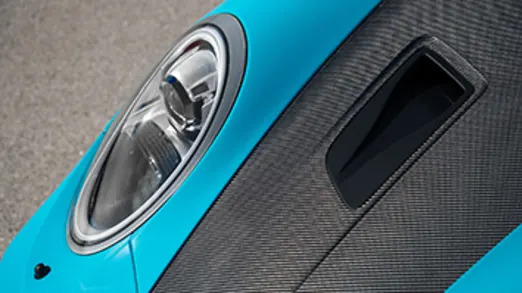
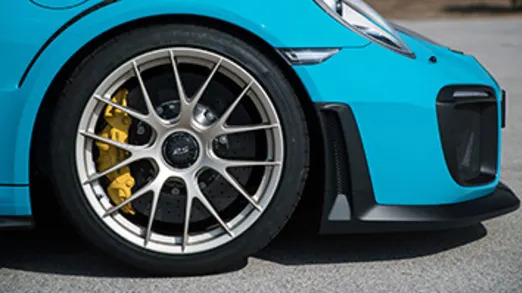
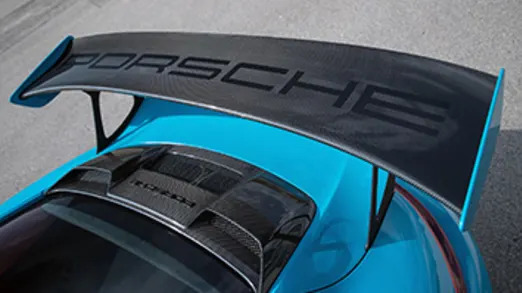
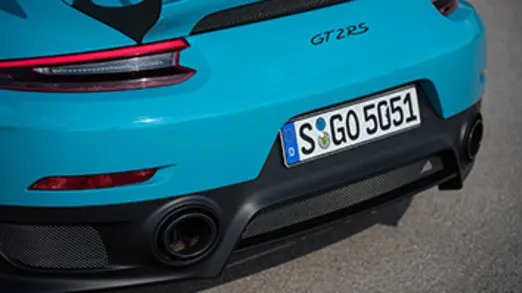
It's hard for enthusiasts to find fault in Preuninger's latest creation, at least on paper. Though power is only driven to the rear wheels, the GT2 RS recently ran a record-setting 6:42.3 at the Nürburgring Nordschleife, beating the 887 horsepower, all-wheel drive 918 Spyder's time by a boggling 10 seconds. It also shamed the most recent record holder, the Lamborghini Huracán Performante. But numbers only tell half the story, so we traveled to Portugal Portimão circuit to get the full seat-of-the-pants scoop on this 700 horsepower beast.
Beating the venerable 918 Spyder at the Nürburgring requires a fearsome power-to-weight ratio, hardcore engine tuning, a reworked suspension setup, and a touch of luck. As such, the GT2 RS's weight loss regime involved everything from carbon fiber bucket seats (saving around 31 pounds) and a magnesium roof (2.2 pounds lighter) to deleted rear seats (21 pounds) and the use of carbon door hinges (trimming 1.7 pounds). Incorporating Gorilla Glass at the rear also did away with 7.7 pounds. Counting the loss of all-wheel drive hardware, the GT2 RS jettisons around 300 pounds compared to an equivalent 911 Turbo S, totaling 3,241 pounds. The $31,000 Weissach package saves an additional 40 pounds and includes exotica like carbon fiber stabilizer bars, magnesium wheels, a titanium roll cage (for non-U.S. markets), and a three-layer carbon fiber roof panel; That's about $775 per pound saved, for those counting at home.
Porsche has jacked the GT2 RS's output to 700 horsepower and 553 lb-ft of torque, a considerable leap over the Turbo S's 580 horsepower. The Turbo S-derived variable geometry twin turbochargers now feature larger turbines and compressors, enabling the 3.8-liter flat six to spin to 7,200 rpm. Upgraded bits include the crankcase and pistons, while a multitube air filter sees its first use in a production car, incorporating five tubes for increased cooling surface area. Another novel feature involves a 5-liter carbon fiber tank in the cargo area. The reservoir feeds water to two nozzles that spray the netting along the intercooler, reducing charge temperatures by as much as 70º F. The system only runs during extreme temperatures (think 100º F + ambient temperatures), and the engine continues to operate normally if the water is depleted. NACA ducts on the hood cool the front brakes, while louvers on the wheelwell extract air, aiding front downforce.
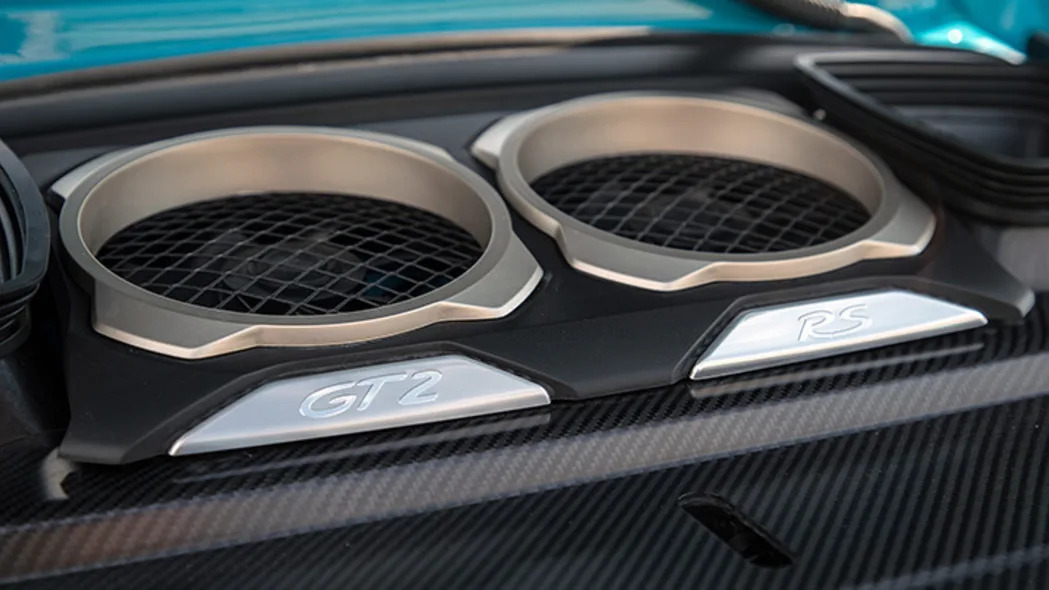
For the first time in a Porsche street car, all suspension connections use steel ball joints instead of rubber bushings. Dynamic engine mounts also help keep the powerplant fixed to the chassis during aggressive acceleration, eliminating the effects of unexpected axle loading.
Swing the GT2 RS's door open and you'll notice a surprising heft despite the extensive lightweighting elsewhere. Unlike the 918's surprisingly wispy doors, the RS retains its stout, 911-based crash structure (it does, however, use nylon strap door handles, a hat tip to RS models of yore). Getting seated involves a bit of a posterior dexterity; it's almost impossible not to fall into the deep bucket seats with an ungainly plop. Once in place, the cockpit exudes a sense of functionality trimmed in Alcantara – lots of Alcantara – from the steering wheel and gear selector to the headliner, seats and door panels. U.S. cars can't be legally equipped with a roll cage, but cars purchased through May 2018 can be ordered with a stereo delete; after then, all vehicles will be legally required to have a backup camera and, in this case, a navigation screen. A/C delete is another no-charge option.
The ignition key turns with your left hand, a tradition Porsche has adhered to despite the ubiquity of engine start/stop buttons, and the flat six growls to life through a titanium muffler. Since the RS is always in track mode, Porsche drops the familiar manettino-style dial from the wheel. The only powertrain settings on this rear-drive monster are PDK Sport, stability control off, and stability and traction control off. If you're into even growlier sounds, a sport exhaust button frees further decibels via a tailpipe flap.
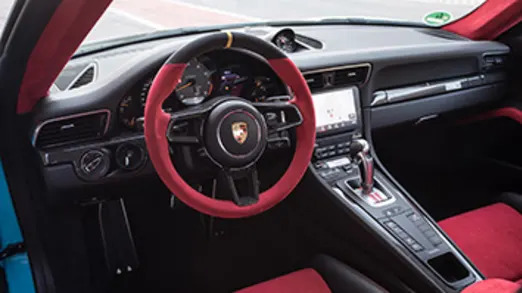

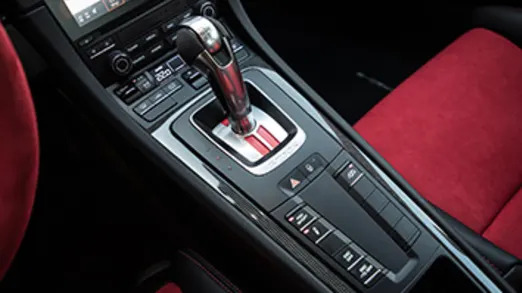
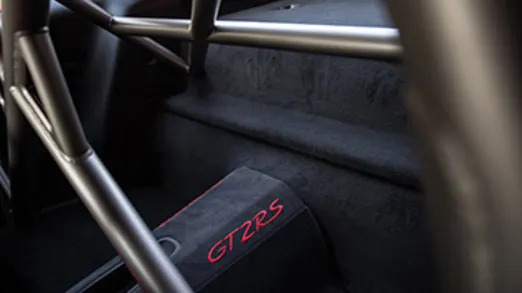
Off the line you'll notice a steady ramp up of grunt that accentuates the twin-turbocharger's power amplifying effect. Keep an eye on the digital gauge and you'll notice that boost doesn't really kick in until around 2,500 rpm or so, depending on engine load. The RS feels light as it accelerates, but anything more than moderate throttle input creates fierce forward motion. Dip hard into that right pedal and the power is immense and awesome, especially when turbo boost thickens around 4,500 rpm. Aggressive driving can close gaps in traffic that shouldn't be feasible in a land-based vehicle — it's that quick. At full tilt, the GT2 RS sprints to 60 mph from a standstill in a whiplash-worthy 2.7 seconds, putting it on par with some of the quickest production cars on the market. Interestingly, its 211 mph top speed was electronically limited due to the tires. Porsche engineers say the fully uncorked drivetrain could hit 220 mph.
While the modified 7-speed dual-clutch transmission shifts quickly and is smooth enough in regular or PDK Sport mode for everyday use. Though you might have the itch to tap the small steering wheel-mounted paddle shifters, in automatic mode the PDK shifts intuitively enough to obviate the need to swap cogs manually. The only two times I found it more satisfying to shift manually was during a brief downpour when I preferred being in full control of torque delivery, and when I wanted to appease gesticulating locals with the dramatic sounds of the crackling, wailing exhaust. Incidentally, my big-winged, hornet-liveried tester drew just as much visible awe from the Portuguese as did Lamborghinis and McLarens I've tested there in the past.
The sport exhaust setting is fun for a show, but standard mode is plenty loud for most conditions and can get tiresome on longer highway drives, with an especially irksome resonance at around 2,200 rpm. Tire noise from the Michelin Pilot Cup Sport 2s is also considerable at highway speeds, and the carbon ceramic stoppers can be noisy and soft before they're warmed up. Adult drivers will likely find gripes with the GT2 RS's cockpit racket, but given the fact that this is the most relentlessly performance-focused Porsche money can buy at the moment, it's safe to say that if it's too loud you're too old ... or something like that.
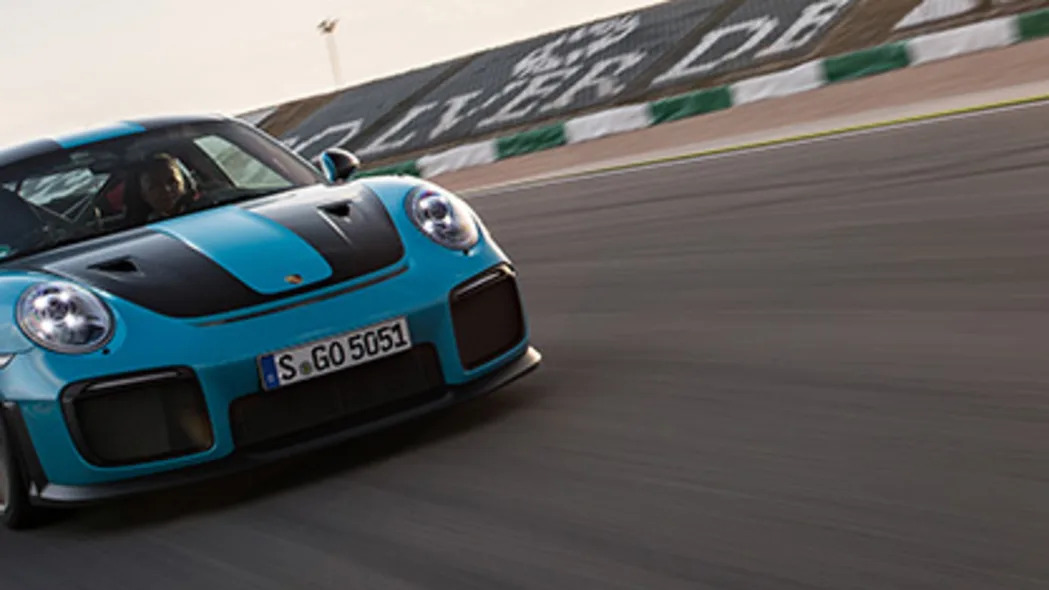
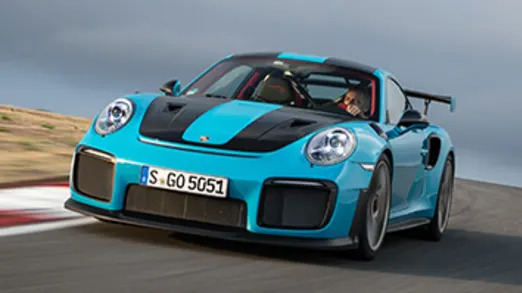

Though the GT2 RS offers serious shock and awe on public roads, it's far better suited to places like the 2.9-mile Algarve International Circuit in Portimão, Portugal. Chasing a 918 Spyder piloted by none other than Lars Kern, the Porsche test driver who set the lap record at the Nürburgring, reveals a great deal about the RS's relative performance limits. For starters, there's the obvious incredible capacity for devouring straight-line distance. Engine torque is so robust that I managed to spin the tires in third gear, going uphill. Thankfully the traction control system is seamless enough that these brief moments of wheelspin are hard to perceive unless your butt-o-meter is particularly sensitive, or you have the luxury of looking down at the dashboard for the little yellow traction light. Stay smooth and even-handed with the throttle, and you'll be rewarded with surprisingly compliant dynamics which communicate the exact relationship between car, chassis, and tire contact.
One surprising aspect of the RS is the surprisingly soft and forgiving turn-in at lower speeds, which runs counter to the RS's hardcore philosophy. Shouldn't a savage track machine have razor sharp on-center feel and turn-in? For starters, while the RS's rear-axle steer system is calibrated for track use (as opposed to Turbo S, which uses a more street-friendly setting) the larger 21-inch rear wheels are so snug in the wheel wells they countersteer about half as much as the Turbo S.
But here's the interesting thing about the RS's front/rear dynamics: you'll thank your lucky stars that turn-in isn't overly reactive because the rear end has a strong tendency to rotate. Sure, the throttle wags the tail—700 hp and 553 lb-ft will do that, even with sticky 325mm tires. But there's also a propensity for the tail to turn when releasing the throttle. A lot of factors come into play with high-speed cornering, including downforce (which approaches 1,000 pounds at top speed, when the RS's rear wing is in its more aggressive position). But a key characteristic of the RS's behavior is how lively that rear end can get. When asked about the tuning, Kern told Autoblog that rear camber and toe were dialed out for greater high-speed stability during the record run at the 'Ring. We believe it, since the rear end would have become unglued during hard braking from high speeds at the 12.9-mile circuit.

That said, the RS has extremely high lateral grip in the dry and a surprisingly playful demeanor as long as driver inputs are delicate. A faint whiff of understeer is a welcome tendency when flinging the RS around a corner, not only because the tail is capable of coming around so quickly, but also because it's so easy to neutralize with an extra millimeter or two of throttle. Lift off in a high-speed corner (as I did briefly while hurtling along the high-speed right-hander leading to the 3,100-foot straight), and the tail steps out dramatically, caught almost immediately by stability control. It took a few hundred feet for me to catch my breath. But before long I was back on it again, seeing an indicated 180 mph at the end of the straight before hard braking.
It's a testimony to the RS's high-speed stability and highly effective brakes that my confidence was restored so quickly. While the RS requires a bit more technique than the 918 Spyder, which creates seamlessly flat cornering and uses torque vectoring to make you feel like a rock star, the most extreme 911 isn't quite the widowmaker you might expect a big-winged, 3,241-lb, 700 hp track weapon to be. Two laps in a sudden rainstorm accentuate just how manageable the chassis is. Though attempting to tap into the car's full potential is an (obviously) futile endeavor in the wet, at least the RS still manages to feel intuitive to anyone with a confident grasp of wet driving dynamics.
The 40-minute drive home from the track reinforces the GT2 RS's fearsome, focused personality. Though ride quality is surprisingly compliant for such a track-oriented car, the road noise and exhaust note might make you wish you took the Range Rover for your long distance slog.
But that's not remotely damning for this latest, greatest track toy—in fact, it's exactly the kind of car Porsche needs, since this is represents the performance pinnacle of their 22-car 911 lineup. If the stripped-down T isn't supercar enough, or if the Turbo S is simply too refined and smoothed out, the GT2 RS is just nasty enough to satisfy your thrillseeking side. And that nearly $300,000 price tag? Complain not, my friend; Porsche will only build around 2,500 GT2 RSs, and the demand has already far exceeded the supply.
Related Video:
"We wanted to make an honest turbo," Porsche's Andreas Preuninger, who's in charge of Porsche high-performance GT range of cars like the 911 GT3 and Cayman GT4, says, "because nowadays turbos tend to get modified in a way that they feel like 10-liter [naturally aspirated] engines, and that's not the point." Preuninger's voice speeds up, like a whirring compressor. "I think a turbo motor has so many interesting sounds and characteristics... I wanted this turbo to burble and overrun, to make hissing sounds of the wastegate and mechanical noises. The breathing of the engine, the way it builds up power—even a little turbo lag, why not? The GT2 RS had to be different, and it is. Big time."
A large part of Preuninger's job involves preserving the company's sporting soul in roadgoing vehicles, which is a particularly critical part of Porsche's business. Get a GT right, and you can quell the critics who say the manufacturer is losing the plot by building Cayennes and Panameras; get it wrong, and you risk alienating the diehards and Porsche evangelists. This time around, Preuninger went old school to create that elusive difference: he dug into the Porsche museum collection and put a 1970s-era 935 Turbo and several turbocharged racecars on a lift, measuring things like intake runner lengths and the header diameters. The findings helped shape the GT2 RS's inimitable howl.




It's hard for enthusiasts to find fault in Preuninger's latest creation, at least on paper. Though power is only driven to the rear wheels, the GT2 RS recently ran a record-setting 6:42.3 at the Nürburgring Nordschleife, beating the 887 horsepower, all-wheel drive 918 Spyder's time by a boggling 10 seconds. It also shamed the most recent record holder, the Lamborghini Huracán Performante. But numbers only tell half the story, so we traveled to Portugal Portimão circuit to get the full seat-of-the-pants scoop on this 700 horsepower beast.
Beating the venerable 918 Spyder at the Nürburgring requires a fearsome power-to-weight ratio, hardcore engine tuning, a reworked suspension setup, and a touch of luck. As such, the GT2 RS's weight loss regime involved everything from carbon fiber bucket seats (saving around 31 pounds) and a magnesium roof (2.2 pounds lighter) to deleted rear seats (21 pounds) and the use of carbon door hinges (trimming 1.7 pounds). Incorporating Gorilla Glass at the rear also did away with 7.7 pounds. Counting the loss of all-wheel drive hardware, the GT2 RS jettisons around 300 pounds compared to an equivalent 911 Turbo S, totaling 3,241 pounds. The $31,000 Weissach package saves an additional 40 pounds and includes exotica like carbon fiber stabilizer bars, magnesium wheels, a titanium roll cage (for non-U.S. markets), and a three-layer carbon fiber roof panel; That's about $775 per pound saved, for those counting at home.
Porsche has jacked the GT2 RS's output to 700 horsepower and 553 lb-ft of torque, a considerable leap over the Turbo S's 580 horsepower. The Turbo S-derived variable geometry twin turbochargers now feature larger turbines and compressors, enabling the 3.8-liter flat six to spin to 7,200 rpm. Upgraded bits include the crankcase and pistons, while a multitube air filter sees its first use in a production car, incorporating five tubes for increased cooling surface area. Another novel feature involves a 5-liter carbon fiber tank in the cargo area. The reservoir feeds water to two nozzles that spray the netting along the intercooler, reducing charge temperatures by as much as 70º F. The system only runs during extreme temperatures (think 100º F + ambient temperatures), and the engine continues to operate normally if the water is depleted. NACA ducts on the hood cool the front brakes, while louvers on the wheelwell extract air, aiding front downforce.

For the first time in a Porsche street car, all suspension connections use steel ball joints instead of rubber bushings. Dynamic engine mounts also help keep the powerplant fixed to the chassis during aggressive acceleration, eliminating the effects of unexpected axle loading.
Swing the GT2 RS's door open and you'll notice a surprising heft despite the extensive lightweighting elsewhere. Unlike the 918's surprisingly wispy doors, the RS retains its stout, 911-based crash structure (it does, however, use nylon strap door handles, a hat tip to RS models of yore). Getting seated involves a bit of a posterior dexterity; it's almost impossible not to fall into the deep bucket seats with an ungainly plop. Once in place, the cockpit exudes a sense of functionality trimmed in Alcantara – lots of Alcantara – from the steering wheel and gear selector to the headliner, seats and door panels. U.S. cars can't be legally equipped with a roll cage, but cars purchased through May 2018 can be ordered with a stereo delete; after then, all vehicles will be legally required to have a backup camera and, in this case, a navigation screen. A/C delete is another no-charge option.
The ignition key turns with your left hand, a tradition Porsche has adhered to despite the ubiquity of engine start/stop buttons, and the flat six growls to life through a titanium muffler. Since the RS is always in track mode, Porsche drops the familiar manettino-style dial from the wheel. The only powertrain settings on this rear-drive monster are PDK Sport, stability control off, and stability and traction control off. If you're into even growlier sounds, a sport exhaust button frees further decibels via a tailpipe flap.




Off the line you'll notice a steady ramp up of grunt that accentuates the twin-turbocharger's power amplifying effect. Keep an eye on the digital gauge and you'll notice that boost doesn't really kick in until around 2,500 rpm or so, depending on engine load. The RS feels light as it accelerates, but anything more than moderate throttle input creates fierce forward motion. Dip hard into that right pedal and the power is immense and awesome, especially when turbo boost thickens around 4,500 rpm. Aggressive driving can close gaps in traffic that shouldn't be feasible in a land-based vehicle — it's that quick. At full tilt, the GT2 RS sprints to 60 mph from a standstill in a whiplash-worthy 2.7 seconds, putting it on par with some of the quickest production cars on the market. Interestingly, its 211 mph top speed was electronically limited due to the tires. Porsche engineers say the fully uncorked drivetrain could hit 220 mph.
While the modified 7-speed dual-clutch transmission shifts quickly and is smooth enough in regular or PDK Sport mode for everyday use. Though you might have the itch to tap the small steering wheel-mounted paddle shifters, in automatic mode the PDK shifts intuitively enough to obviate the need to swap cogs manually. The only two times I found it more satisfying to shift manually was during a brief downpour when I preferred being in full control of torque delivery, and when I wanted to appease gesticulating locals with the dramatic sounds of the crackling, wailing exhaust. Incidentally, my big-winged, hornet-liveried tester drew just as much visible awe from the Portuguese as did Lamborghinis and McLarens I've tested there in the past.
The sport exhaust setting is fun for a show, but standard mode is plenty loud for most conditions and can get tiresome on longer highway drives, with an especially irksome resonance at around 2,200 rpm. Tire noise from the Michelin Pilot Cup Sport 2s is also considerable at highway speeds, and the carbon ceramic stoppers can be noisy and soft before they're warmed up. Adult drivers will likely find gripes with the GT2 RS's cockpit racket, but given the fact that this is the most relentlessly performance-focused Porsche money can buy at the moment, it's safe to say that if it's too loud you're too old ... or something like that.



Though the GT2 RS offers serious shock and awe on public roads, it's far better suited to places like the 2.9-mile Algarve International Circuit in Portimão, Portugal. Chasing a 918 Spyder piloted by none other than Lars Kern, the Porsche test driver who set the lap record at the Nürburgring, reveals a great deal about the RS's relative performance limits. For starters, there's the obvious incredible capacity for devouring straight-line distance. Engine torque is so robust that I managed to spin the tires in third gear, going uphill. Thankfully the traction control system is seamless enough that these brief moments of wheelspin are hard to perceive unless your butt-o-meter is particularly sensitive, or you have the luxury of looking down at the dashboard for the little yellow traction light. Stay smooth and even-handed with the throttle, and you'll be rewarded with surprisingly compliant dynamics which communicate the exact relationship between car, chassis, and tire contact.
One surprising aspect of the RS is the surprisingly soft and forgiving turn-in at lower speeds, which runs counter to the RS's hardcore philosophy. Shouldn't a savage track machine have razor sharp on-center feel and turn-in? For starters, while the RS's rear-axle steer system is calibrated for track use (as opposed to Turbo S, which uses a more street-friendly setting) the larger 21-inch rear wheels are so snug in the wheel wells they countersteer about half as much as the Turbo S.
But here's the interesting thing about the RS's front/rear dynamics: you'll thank your lucky stars that turn-in isn't overly reactive because the rear end has a strong tendency to rotate. Sure, the throttle wags the tail—700 hp and 553 lb-ft will do that, even with sticky 325mm tires. But there's also a propensity for the tail to turn when releasing the throttle. A lot of factors come into play with high-speed cornering, including downforce (which approaches 1,000 pounds at top speed, when the RS's rear wing is in its more aggressive position). But a key characteristic of the RS's behavior is how lively that rear end can get. When asked about the tuning, Kern told Autoblog that rear camber and toe were dialed out for greater high-speed stability during the record run at the 'Ring. We believe it, since the rear end would have become unglued during hard braking from high speeds at the 12.9-mile circuit.

That said, the RS has extremely high lateral grip in the dry and a surprisingly playful demeanor as long as driver inputs are delicate. A faint whiff of understeer is a welcome tendency when flinging the RS around a corner, not only because the tail is capable of coming around so quickly, but also because it's so easy to neutralize with an extra millimeter or two of throttle. Lift off in a high-speed corner (as I did briefly while hurtling along the high-speed right-hander leading to the 3,100-foot straight), and the tail steps out dramatically, caught almost immediately by stability control. It took a few hundred feet for me to catch my breath. But before long I was back on it again, seeing an indicated 180 mph at the end of the straight before hard braking.
It's a testimony to the RS's high-speed stability and highly effective brakes that my confidence was restored so quickly. While the RS requires a bit more technique than the 918 Spyder, which creates seamlessly flat cornering and uses torque vectoring to make you feel like a rock star, the most extreme 911 isn't quite the widowmaker you might expect a big-winged, 3,241-lb, 700 hp track weapon to be. Two laps in a sudden rainstorm accentuate just how manageable the chassis is. Though attempting to tap into the car's full potential is an (obviously) futile endeavor in the wet, at least the RS still manages to feel intuitive to anyone with a confident grasp of wet driving dynamics.
The 40-minute drive home from the track reinforces the GT2 RS's fearsome, focused personality. Though ride quality is surprisingly compliant for such a track-oriented car, the road noise and exhaust note might make you wish you took the Range Rover for your long distance slog.
But that's not remotely damning for this latest, greatest track toy—in fact, it's exactly the kind of car Porsche needs, since this is represents the performance pinnacle of their 22-car 911 lineup. If the stripped-down T isn't supercar enough, or if the Turbo S is simply too refined and smoothed out, the GT2 RS is just nasty enough to satisfy your thrillseeking side. And that nearly $300,000 price tag? Complain not, my friend; Porsche will only build around 2,500 GT2 RSs, and the demand has already far exceeded the supply.
Related Video:











Sign in to post
Please sign in to leave a comment.
Continue